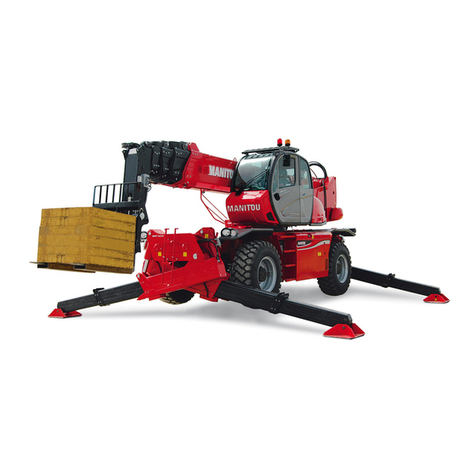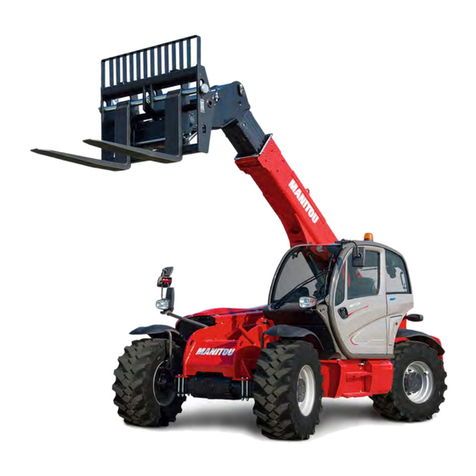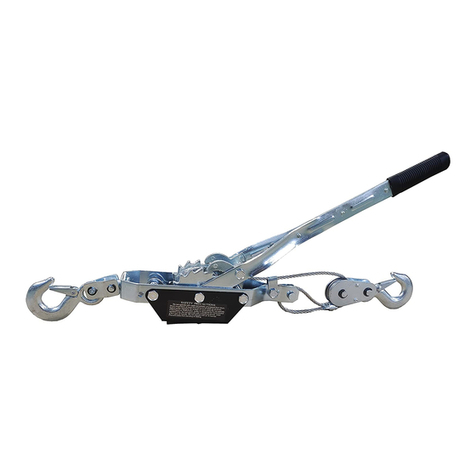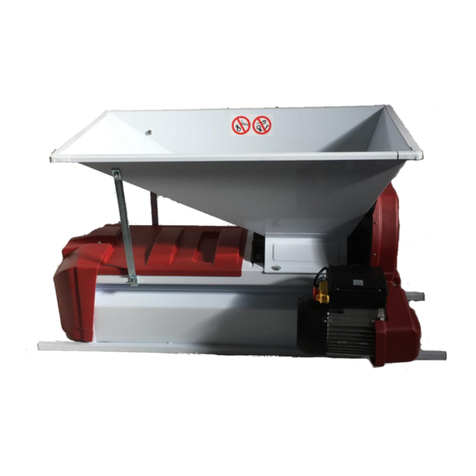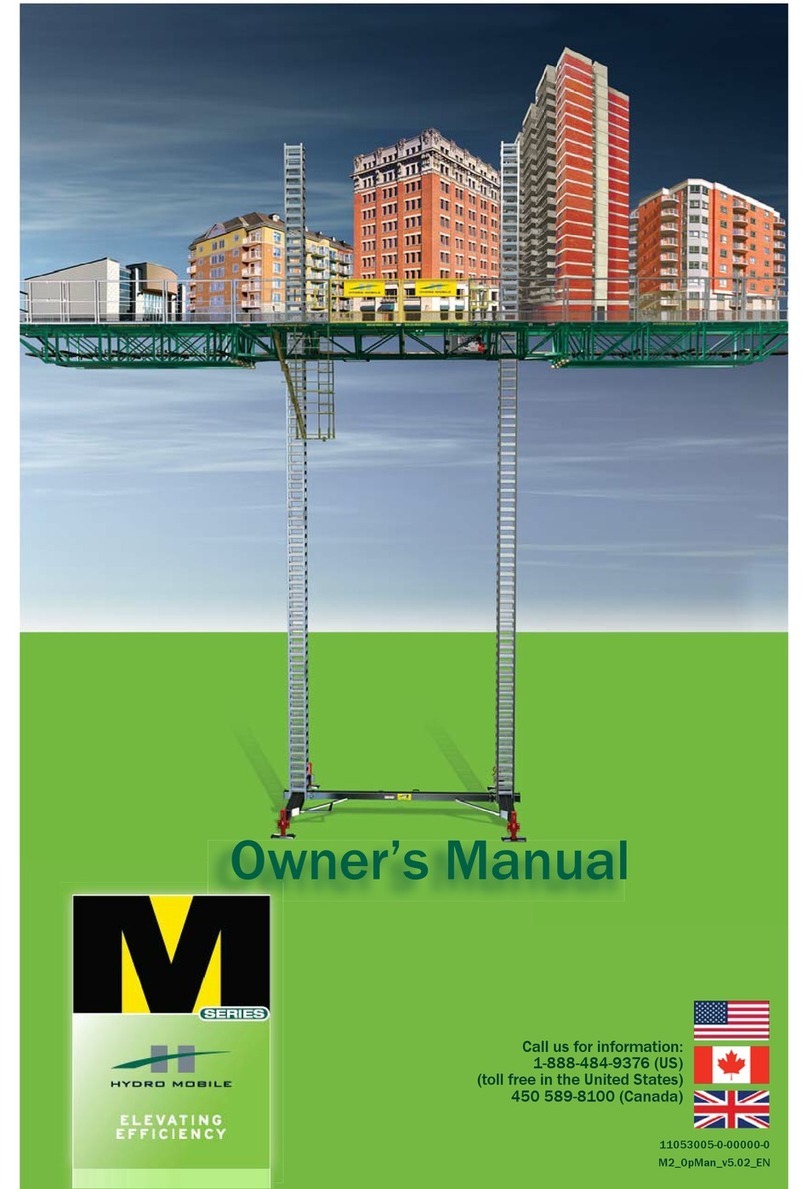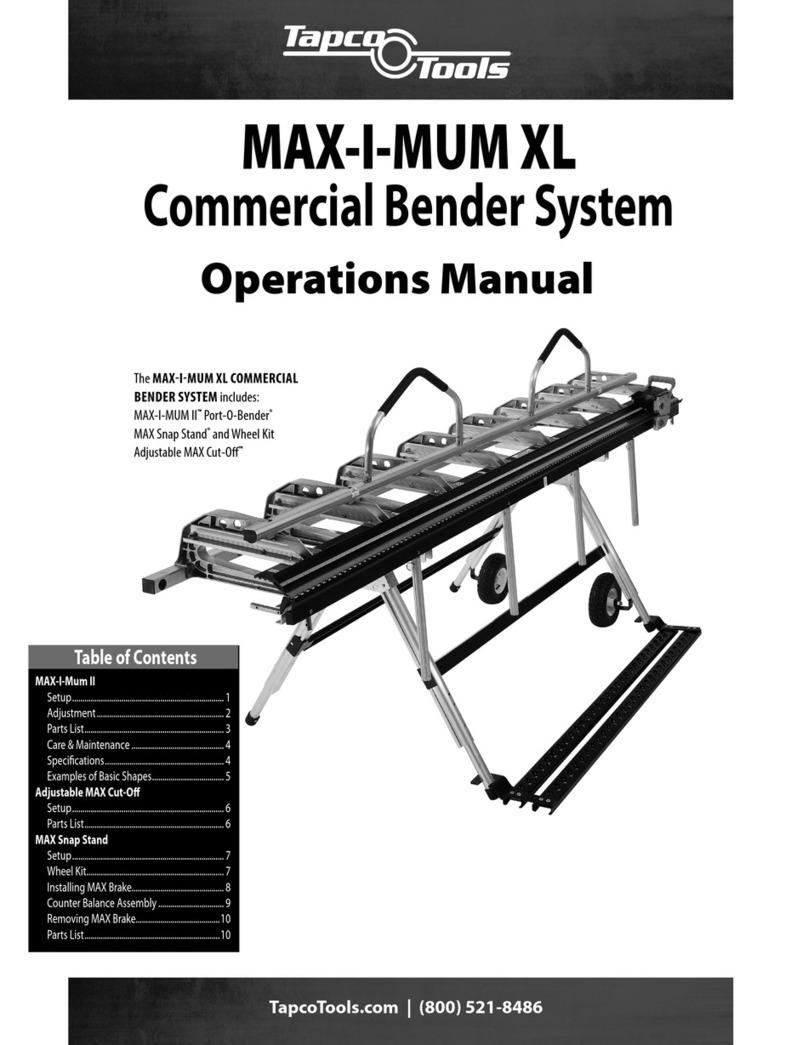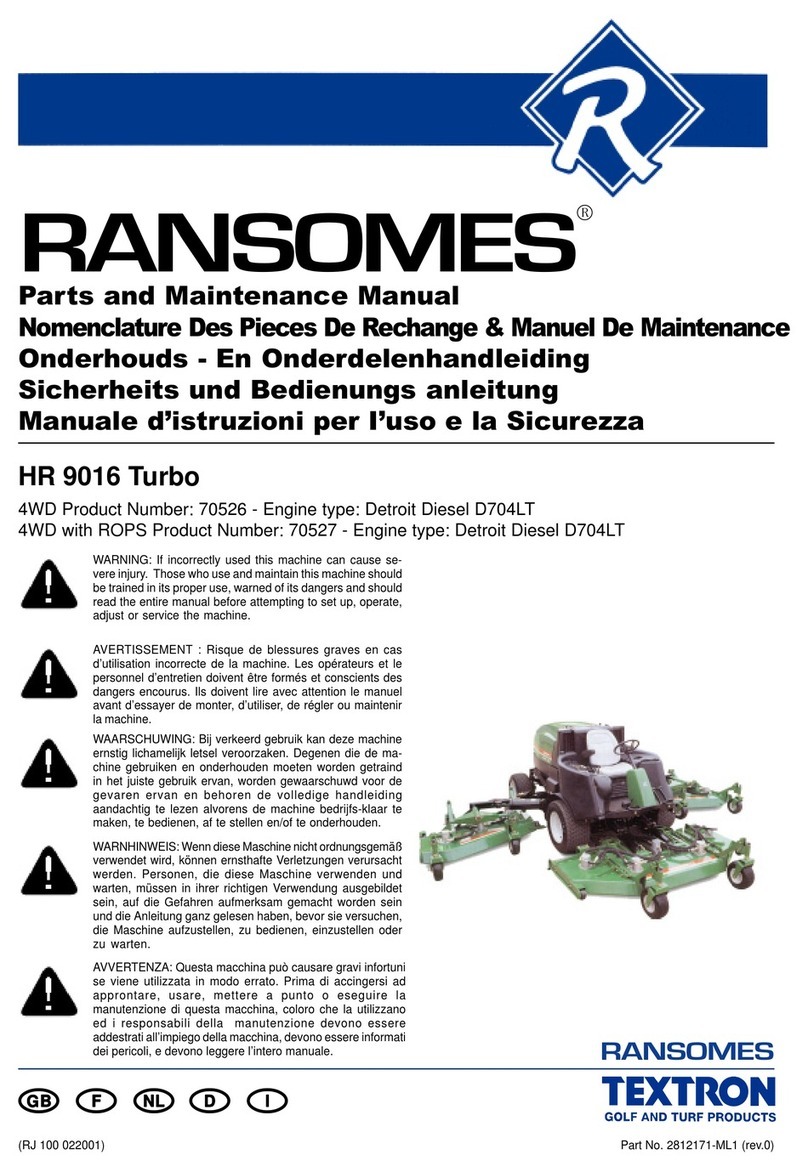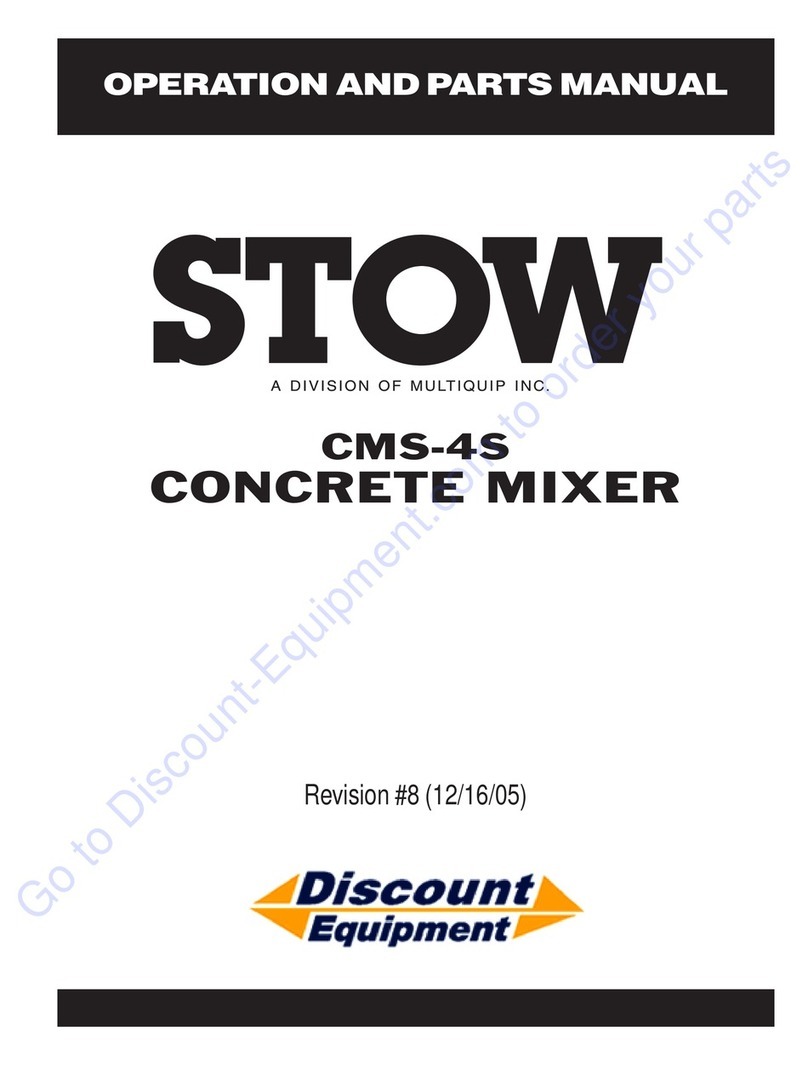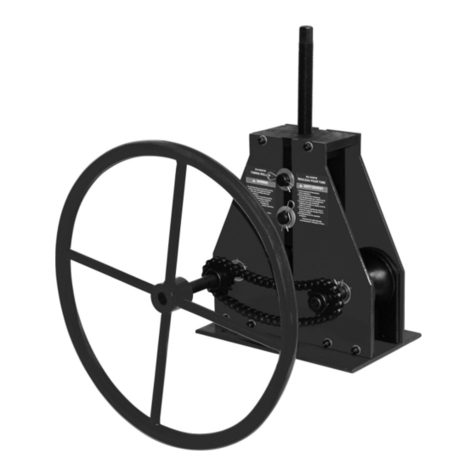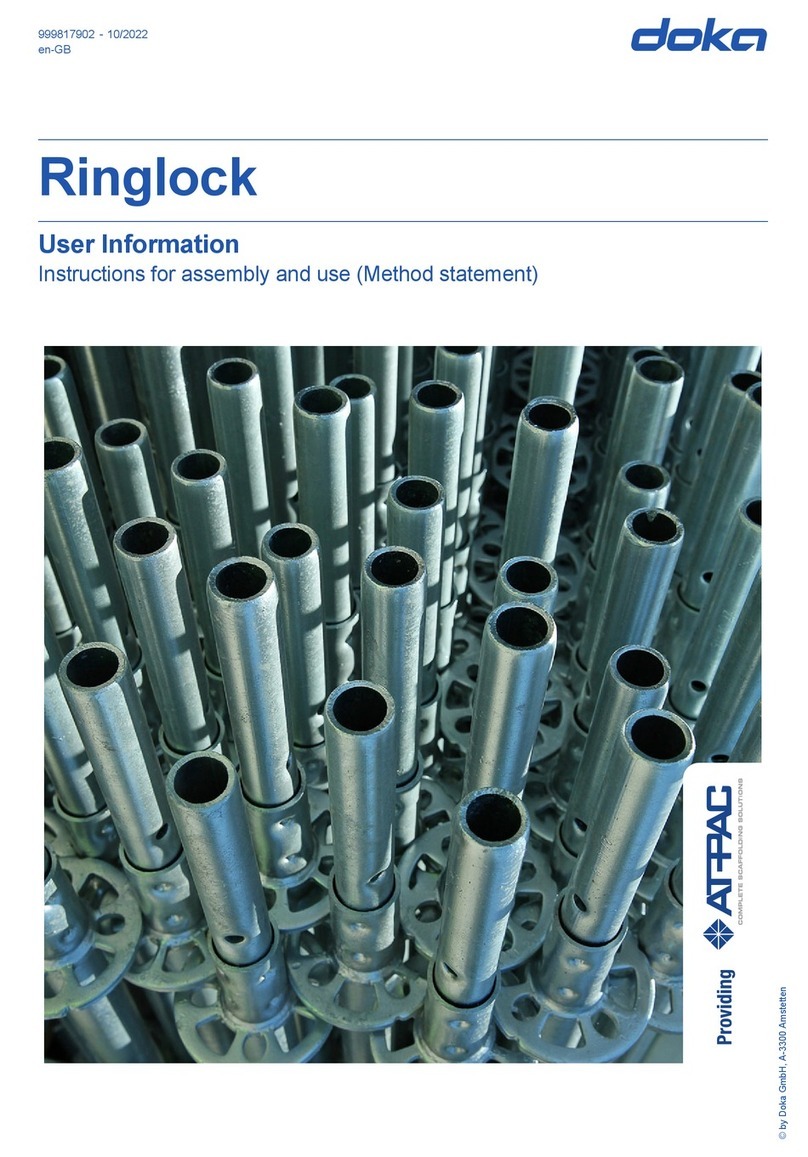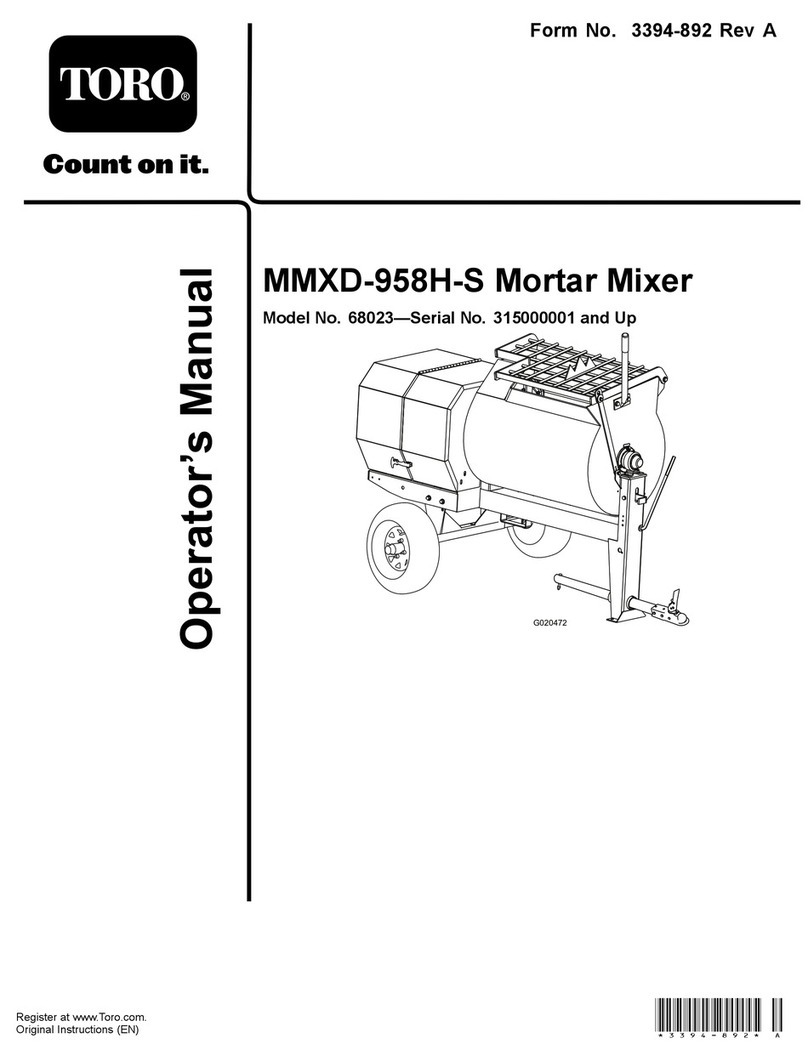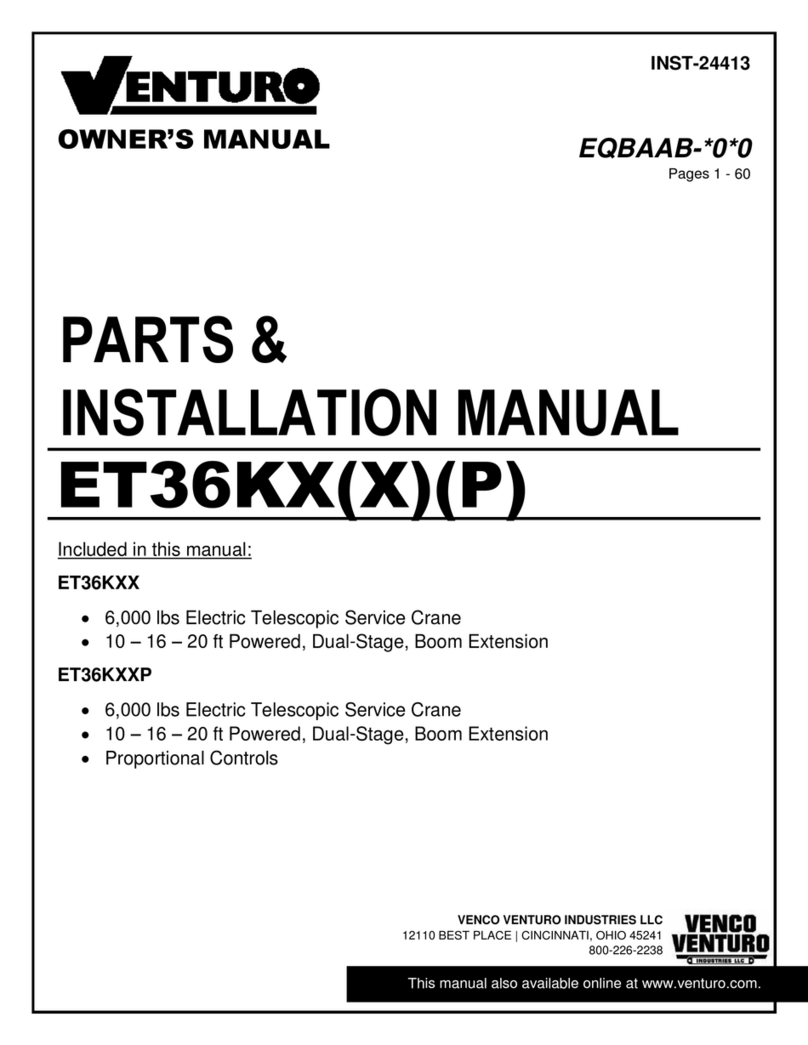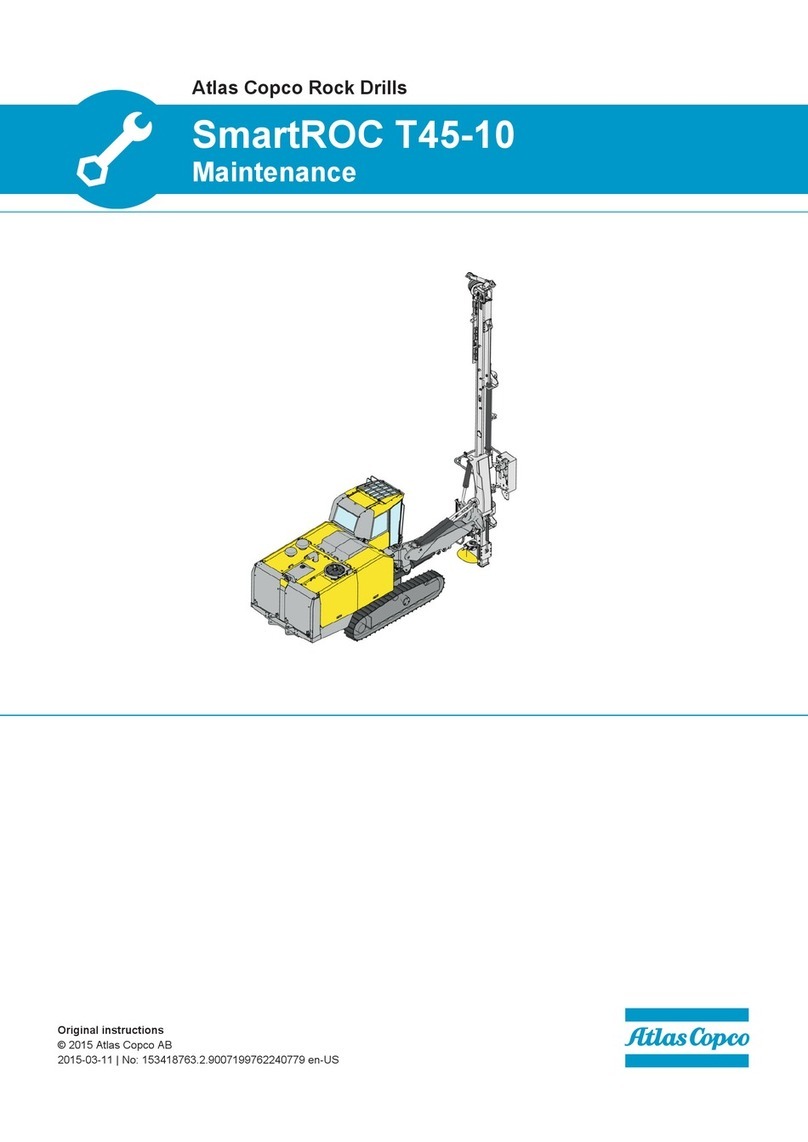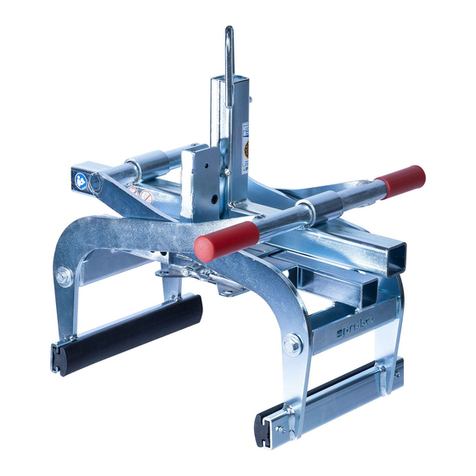Manitou Privilege MRT-X 3255 PLUS User manual

648870 IT-EN-DE (04/05/2015)
IL VOSTRO CONCESSIONARIO :
YOUR DEALER:
IHR VERTRAGSHÄNDLER:
MANUALE D’ISTRUZIONI
(ISTRUZIONI ORIGINALI)
OPERATOR’S MANUAL
(ORIGINAL INSTRUCTIONS)
BETRIEBSANLEITUNG
(ORIGINALBETRIEBSANLEITUNG)
QUESTO MANUALE D’ISTRUZIONI DEVE SEMPRE RIMANERE NEL CARRELLO ELEVATORE E DEVE ESSERE INTEGRALMENTE LETTO E COMPRESO DAGLI OPERATORI.
THIS OPERATOR’S MANUAL MUST BE KEPT IN THE LIFT TRUCK AND MUST BE READ AND UNDERSTOOD BY OPERATORS.
DIESE BETRIEBSANLEITUNG MUSS SICH STETS IM TELESKOPLADER BEFINDEN. ALLE BEDIENER MÜSSEN DIE BETRIEBSANLEITUNG SORGFÄLTIG DURCHGELESEN UND SICH IHREN
INHALT VERSTÄNDLICH GEMACHT HABEN.
MANITOU ITALIA S.r.l.
Via Cristoforo Colombo, 2 - Località Cavazzona
41013 CASTELFRANCO EMILIA (MO) - ITALIA
Tel. +39 059 95 98 11 - Fax +39 059 95 98 50
MRT-X 3255 PLUS
MRT 3255 PLUS

648870 IT-EN-DE (04/05/2015)

648870 IT-EN-DE (04/05/2015)
1 - ISTRUZIONI E NORME DI
SICUREZZA
2 - DESCRIZIONE
3 - MANUTENZIONE
4 - ACCESSORI ADATTABILI IN
OPZIONAL PER LA GAMMA
03/04/2015
04/05/2015
PRIMA EDIZIONE - 1ST DATE OF ISSUE - ERSTAUSGABEDATUM
AGGIORNAMENTO- UPDATING - AKTUALISIERUNG
E’ vietata la riproduzione, anche
parziale, del testo e delle illustrazioni.
La differenza tra i tempi di aggiornamento
in stampa e i tempi delle modifiche
tecniche (variando quast’ultime
continuamente, ciò al fine di offrire
prodotti sempre più qualificati) impongono
di dichiarare, per correttezza, che i dati
contenuti nella presente edizione sono
suscettibili di variazione in qualsiasi
momento e che quindi non sono
impegnativi.
Text and illustrations herewith enclosed
may not be reproduced, not even in part
and by any means.
Because of the possible
le time lag between the introduction of
technical modifications
(an on-going process the aim of which
is to offer products which are being
continually improved) and the latest up
date of the manual, we must point out,
for the sake of correctness, that the data
contained in this edition is liable to change
at any time and are therefore not
binding.
Die Reproduktion, auch nur teilweise,
dieses Textes und der Abbidungen ist
verboten.
Aus Gründen der Korrektheit muß
darauf hingewiesen werden, daS der
Zeitunterschied zwischen in Druck
befindlicher Naufassung und technischen
Veränderungen (die für ein Angebot von
immer basseren Geräten kontinuierlich
sind) zu Unterscheden in den Angaben
dieser Auflage Fühuren kann und daß die
darin enthaltenen Angaben underbindlinch
sind und jederzeit verändert werden
können.
IT FR ES
1 - OPERATING AND SAFETY
INSTRUCTIONS
2 - DESCRIPTION
3 - MAINTENANCE
4 - ADAPTABLE ATTACHMENTS
IN OPTION ON THE RANGE
1 - SICHERHEITSHINWEISE
UND -VORSCHRIFTEN
2 - BESCHREIBUNG
3 - WARTUNG
4 - ANBAUGERÄTE FÜR DIE
TELESKOPLADER-BAUREIHE

648870 IT-EN-DE (04/05/2015)

648870 IT-EN-DE (04/05/2015)



648870 IT-EN-DE (04/05/2015)

1-3
IT EN DE
ORIGINAL REPLACEMENT PARTS AND
ATTACHMENTS
All maintenance on our lift trucks
must be carried out using original
parts.
By allowing non-original parts to be
used, you run the risk:
- Legally, of being liable in the event of an
accident.
- Technically, of causing breakdowns to
occur or of reducing your lift truck's servi-
ce life.
Using counterfeit parts or components
not approved by the manufacturer may
put an end to contract warranty terms
and lead the maker to withdraw the lift
truck's certificate of compliance.
By using original parts during mainte-
nance operations,
you are legally cove-
ring yourself.
- Any user who procures parts from
another quarter does so at his own
risk.
- Any user who modifies his lift truck or
has it modified by a service company,
must consider that a new item of
equipment has been brought onto the
market and therefore takes liability for
it.
- Any user who copies original parts or
has them copied is taking a risk from
the legal viewpoint.
- The certificate of compliance only binds
the maker for parts chosen or
produced
under the maker's control.
- The practicalities of maintenance terms
are set out by the maker. The maker is
in no way liable in the event of the
user not
complying with such terms.
The manufacturer brings to the user:
- His know-how and skill.
- Guaranteed quality work.
- Original replacement parts.
- Help with preventive maintenance.
- Effective help with diagnosing faults.
ERSATZTEILE UND ZUBEHÖR
Zur Instandhaltung unsere
Teleskoplader müssen
Originalersatzteile verwendet werden
Die Verwendung nicht orginaler
Ersatzteile beinhaltet gewisse Risiken
- Im Falle eines Unfalls die rechtlichen
Konsequenzen zu tragen
- Technische Betriebsstörungen
hervorzurufen oder die Lebensdauer des
Gabelstaplers zu verringern.
Die verwendung nicht orginaler
Ersatzteile Teilen oder vom Hersteller
nicht zugelassenen Komponenten führt
zum Erlöschen der vertraglichen Garantie
führen und zwingd den Hersteller zum
Rückzug der Konformitätserklärung zwin-
gen.
Durch den einsatz von originalteilenbei
Instandhaltungsarbeiten,
schützen sie
sich rechtlich.
- Der Benutzer, der seine Ersatzteile ander-
swo bezieht, tut dies auf eigene Gefahr
- Der Benutzer, der seinen Teleskoplader
verändert oder durch einen
Dienstleistungsbetrieb verändern läßt,
muß davon ausgehen, daß ein neues
Produkt auf den Markt kommt und wird
somit haftpflichtig.
- Der Benutzer, der Originalteile kopiert
oder kopieren läßt, setzt sich rechtlichen
Gefahren aus.
- Die Konformitätserklärung bindet den
Hersteller nur für die von ihm gewählten
oder unter seiner Aufsicht agefertigten
Ersatzteile Teile.
- Die praktischen Wartungsbedingungen
werden vom Hersteller definiert. Sollte
der Benutzer diese nicht einhalten, über-
nimmt der Hersteller keine Haftung.
Der Hersteller bietet dem Benutzer:
- Sein Know-how und seine Kompetenz.
- Eine Qualitätsgarantie der
durchgeführten Arbeiten.
- Original Ersatzteile.
- Hilfestellungen zur vorbeugenden
Wartung.
- Eine wirkungsvolle Diagnosehilfe.
RICAMBI E ATTREZZATURE ORIGINALI
La manutenzione dei nostri carrelli
elevatori deve tassativamente essere
realizzata con pezzi originali.
Autorizzando l’utilizzo di pezzi non origi-
nali, rischiate:
- Giuridicamente di coinvolgere la
vostra responsabilità in caso
d’incidente.
- Tecnicamente di causare problemi di
funzionamento alla longevità del
carrello elevatore.
L’utilizzo - da parte dell’utente - di pezzi
contraffatti o di componenti non omologa-
ti può mettere un termine alle condizioni
di garanzia contrattuale e indurre il
costruttore al ritiro del Certificato di
Conformità.
Utilizzando i pezzi originali durante le
operazioni di manutenzione, vi proteg-
gete giuridicamente.
- L’utente che si rifornisce altrove, lo fa a
suo rischio e pericolo.
- L’utente che modifica o fa modificare da
terzi il carrello elevatore, deve essere
consapevole che un nuovo materiale è
messo sul mercato, il che coinvolge la
sua responsabilità.
- L’utente che copia o fa copiare i pezzi
d’origine, si espone a rischi giuridici.
- Il Certificato di Conformità implica la
responsabilità del fabbricante solo per i
pezzi scelti o elaborati sotto il suo con-
trollo.
- Le condizioni pratiche di manutenzione
sono fissate dal fabbricante. Se l’utente
non le rispetta, la responsabilità del fab-
bricante non è coinvolta.
Il fabbricante apporta all’utente:
- Il savoir-faire e la sua competenza.
- La garanzia della qualità dei lavori
realizzati.
- I pezzi di ricambio originali.
- Un’assistenza alla manutenzione
preventiva.
- Un’efficace assistenza alla diagnosi.
648870 IT-EN-DE (04/05/2015)

1-4
- Enhancements gained from feedback.
- Training for operating staff.
- Only the manufacturer knows the
details of the lift truck design and the
refore has the best technological capa
bility to carry out maintenance.
Original replacement parts are distribu-
ted exclusively
by MANITOU and its dealer network.
You can obtain the list of dealers by pho-
ning the spare parts department on :
TEL : 0033240091011
- Ständige Weiterentwicklung der
Produkte.
- Eine Ausbildung des Betriebspersonals.
- Nur der Hersteller kennt die Konstruktion
des Teleskopladers im Detail und
verfügt somit über die besten techni
schen Fähigkeiten, um dessen
Wartung zu gewährleisten.
Originalersatzteile werden ausschließli-
ch von MANITOU und dem netz seiner
Vertragshändler
vertrieben.
Ein Anruf bei unserer Ersatzteilabteilung
genügt und Sie erhalten die Liste der
Vertragshändler :
TEL : 0033240091011
IT EN DE
- I miglioramenti dovuti allo scambio di
esperienze.
- La formazione del personale
incaricato.
- Solo il fabbricante conosce
dettagliatamente la progettazione del
carrello e quindi le migliori capacità
tecnologiche per assicurarne la
manutenzione.
I pezzi di ricambio d’origine sono distri-
buiti esclusivamente da
MANITOU
e dalla rete dei concessionari.
La lista della rete dei concessionari può
esservi fornita telefonando al servizio dei
pezzi di ricambio :
TEL : 059950518
648870 IT-EN-DE (04/05/2015)

DRIVER’S OPERATING INSTRUCTION
Caution
Whenever you see this symbol it
means :
Warning! Be careful! Your safety or the
safety of the lift truck is at risk.
- Most accidents connected with the use,
maintenance and repair of the lift truck
are due to non application of the basic
safety instructions. By being aware of the
risks to which you are exposed and by
taking the necessary preventive measu-
res, you should be able to avoid acci-
dents occurring.
- Any operation or manoeuvre not descri-
bed in the instructions is prohibited,
however, any person who does use
another method must first ensure that he
is not putting himself, another person or
the lift truck in danger.
- The manufacturer is not able to anticipa-
te all possible risk situations. Therefore
the safety instructions and notices given
in the user manual and on the lift truck
are not exhaustive.
Any bending of the rules in safety notices
or the user, maintenance or repair
instructions for your lift truck may result
in serious, or even fatal, accidents.
We would remind users of the risks in dri-
ving at excessive speed with regard to
traffic conditions, particularly :
- Risk of loss of control on a poor-qua
lity track.
- Increased stopping distance.
BEDIENUNGSANLEITUNG FÜR
DEN FAHRER
Warnung
Dieses Symbol bedeutet:
Achtung! Seien Sie vorsichtig! Ihre
Sicherheit, die Sicherheit Dritter oder
die des Teleskopladers sind in Gefahr.
- Die meisten Unfälle beim Gebrauch, bei
der Wartung und bei der Reparatur des
Gabelstaplers sind auf die
Nichtanwendung und Nichteinhaltung der
grundlegenden Sicherheitsanweisungen
zurückzuführen. Wenn Sie diese
Gefahren erkennen, und die nötigen vor-
beugenden Maßnahmen treffen, können
Sie diese Unfälle vermeiden.
- Jegliche Anwendung, jedes Manöver,
welches in den Bedienungsanleitung
nicht beschrieben sind, sind von vorn
zu unterlassen.
- Der Hersteller haftet auf keinen Fall für
alle Gefahrensituationen. Die
Anweisungen und Sicherheitsvorschriften
in diesem Handbuch und auf dem
Teleskoplader selbst erheben daher kei-
nen Anspruch auf Vollständigkeit.
Alle Verstöße gegen die
Sicherheitsvorschriften, Bedienungs-,
Wartungs- oder Reparaturanweisungen
Ihres Gabelstaplers können schwere, ja
sogar tödliche Unfälle verursachen.
Beachten Sie die Gefahren, welche durch
nicht angepasste Geschwindigkeit, den
Verkehrsbedingungen,
Witterungsbedingungen und
Fahrbahnbeschaffenheit entstehen:
-Es besteht die Gefahr, in Abhängigkeit
von Geschwindigkeit, Witterung und
Fahrbahnbeschaffenheit die Kontrolle
uber das Fahrzeug zu verlieren
-Der Bremsweg kann sich erheblich
verlängern.
1-5
IT EN DE
ISTRUZIONI D’USO PER IL CARRELLISTA
Avvertenza
Ricordate che questo simbolo significa:
Attenzione! Prudenza! Sono in gioco la
vostra sicurezza e quella del carrello
elevatore.
- La maggior parte degli incidenti legati
all’utilizzo, alla manutenzione e alla ripa-
razione del carrello elevatore, sono dovu-
ti alla non-applicazione e all’inosservanza
delle più elementari norme di sicurezza.
Individuando i rischi ai quali vi esponete
e prendendo tutte le necessarie precau-
zioni, potrete evitare questi incidenti.
- Tutte le operazioni o manovre non
descritte nel manuale d’istruzioni devono
essere evitate, e in ogni caso colui che
utilizza un altro metodo deve prima assi-
curarsi che sia garantita la propria incolu-
mità, quella degli altri e il buono stato del
carrello elevatore.
- Pertanto, non potendo prevedere tutte le
situazioni di pericolo, le istruzioni e
norme di sicurezza relative al carrello ele-
vatore, date dal costruttore e riportate
nel presente manuale, non sono da con-
siderarsi esaustive.
L’inosservanza delle norme di sicurezza o
delle istruzioni d’uso, di manutenzione o di
riparazione del carrello elevatore possono
essere all’origine di gravi infortuni, anche
mortali.
Richiamiamo l’attenzione degli utilizzatori
sui rischi a cui vanno incontro, andando
ad una velocità eccessiva rispetto alle
condizioni di circolazione, in
particolare:
- Rischio di perdere il controllo su stra
da dissestata.
- Aumento dello spazio di frenata.
648870 IT-EN-DE (04/05/2015)

1-6
The user must remain in full control of his
lift truck and should :
- Adapt his speed to each situation in
order to be maintain his own safety,
that of others and of his equipment.
- Always be aware of his stopping
distance.
On the basis of experience, there are a
number of possible situations in which
operating the lift truck is contra-indicated.
Such foreseeable abnormal uses,
the main ones being listed below, are
strictly forbidden.
- The foreseeable abnormal behaviour
resulting from ordinary neglect, but
does not result from any wish to put
the machinery to any improper use.
- The reflex reactions of a person in the
event of a malfunction, incident, fault,
etc. during operation of the lift truck.
- Behaviour resulting from application of
the "principle of least action" when
performing a task.
- For certain machines, the foreseeable
behaviour of such persons as :
apprentices, teenagers, handicapped
persons and trainees tempted to drive
a lift truck. Truck drivers tempted to
operate a truck to win a bet, in
competition or for their own personal
experience.
The person in charge of the equipment
must take these criteria into account
when assessing whether or not a person
will make a suitable driver.
- Get to know the telescopic fork lift
truck on the terrain where it is to be
used.
- Transport the load with the boom
lowered and fully retracted
- Position the forks at right-angles to the
load to be lifted.
- Drive the truck at a speed appropriate
to conditions and the state of the
ground.
- Never go too fast or brake sharply with
a load.
- When picking up a load, check that the
ground is as even as possible.
Der Benutzer muß das Fahrzeug ständig
unter Kontrolle haben :
- Die Geschwindigkeit der Situation
anpassen, um die eigene Sicherheit,
die Sicherheit Dritter und die des
Teleskopladers zu bewahren.
- Den Bremsweg ständig einschätzen
können.
Erfahrungsgemäß können bestimmte
Gegenanzeigen für den Einsatz des
Gabelstaplers auftreten. Diese vorhersehba-
ren, unnormalen Einsätze, von denen die
hauptsächlichen nachstehend genannt wer-
den, sind strengstens untersagt.
-Das vorhersehbare. unnormale
Verhalten aufgrund einer gewòhnlichen
Fahrlàssigkeit. dasjedoch nicht auf
dem Willen eines falschen
Materialeinsatzes beru ht.
-Das Reflexverhalten einer Person bei
einer Funklionsstòrung. einem
Zwischenfall. einer Stòrung. usw. wàh
rend der Benutzung des Gabelstaplers.
-Das Verhalten. das auf der Anwendung
des "Wegs des geringsten
Widerstands" wàhrend der AusfOhrung
einer Arbeit beruht.
-Bei manchen Maschinen das voraus
sehbare Verhalten mancher Personen.
wie z. B.: lehrlinge. Jugendliche.
Behinderte. Praktikanten. die versucht
sind. einen Gabelstapler zu fahren.
Gabelstaplerfahrer. die versucht sind. den
Gabelstapler fOr Wetten. Wettbewerbe
oder fOr ihre eigene Erfahrung einzuset-
zen.
Der verantwortliche Mitarbeiter muß
diese Kriterien bei der Bewertung der
Fahrtüchtigkeit einer Person berücksichti-
gen.
- Machen Sie sich vor jedem Einsatz mit
dem Teleskoplader und den
Geländegegebenheiten vertraut...
- Transportieren Sie die Last in niedriger
Stellung und mit ganz eingefahrenem
Teleskoparm .
- Positionieren Sie die Gabelzinken waa
gerecht zu der anzuhebenden Last.
- Fahren Sie den Gabelstapler mit einer
den Bedingungen und dem Zustand
des Untergrunds angepaßten
Geschwindigkeit.
- Vermeiden Sie beim Fahren mit Last
zu hohe Geschwindigkeit und abrupte
Bremsmanöver.
- Vergewissern Sie sich vor dem
Aufnehmen einer Last, daßder
Untergrund ausreichen tragfähig und
eben ist
IT EN DE
L'utilizzatore deve sempre poter controlla-
re il carrello elevatore e
quindi deve :
- Adattare la velocità ad ogni situazione
per preservare la propria incolumità,
quella altrui e quella della propria
macchina.
- Valutare continuamente lo spazio di
frenata.
L’esperienza ci insegna che si possono
avere alcune controindicazioni sull’impie-
go del carrello elevatore. Questi impieghi
anomali prevedibili, di cui i principali sono
elencati qui di seguito, sono formalmente
vietati.
- Il comportamento anomalo prevedibile,
che risulta da una negligenza ordinaria,
ma che non risulta dalla volontà di fare
un cattivo uso della macchina.
- Il comportamento riflesso di una perso-
na in caso di cattivo funzionamento, d’in-
cidente, di anomalia, ecc. durante l’utiliz-
zo del carrello elevatore.
- Il comportamento risultante dall’applica-
zione della “legge del minimo
sforzo” durante l’esecuzione di un
compito.
- Per alcune macchine, il comportamento
prevedibile di certe categorie di persone,
quali: apprendisti, adolescenti, portatori
di handicap, personale in
formazione.
I carrellisti tentati di utilizzare il carrello
elevatore per scommesse, competizioni o
per esperienza personale.
Il responsabile dello stabilimento deve
tenere conto di questi criteri per valutare
l’attitudine alla guida di una persona.
- Prendere confidenza con il carrello
elevatore telescopico sul terreno dove
sarà utilizzato.
- Trasportare il carico in posizione bassa
e il braccio telescopico rientrato al
massimo .
- Posizionare le forche
perpendicolarmente al carico da
sollevare.
- Guidare il carrello ad una velocità
adeguata alle condizioni e allo stato
del terreno.
- Non andare mai troppo forte né frenare
bruscamente con un carico .
- Al momento di prendere un carico,
verificare che il terreno sia il più
uniforme possibile .
648870 IT-EN-DE (04/05/2015)

- Never attempt to carry out operations
which exceed the lift truck’s capabili
ties.
- Never raise a load in excess of the
lift truck’s capacity and never increase
the size of the ballast.
- Drive around obstacles.
- Take care over electrical wires, tren
ches and recently-excavated or filled
ground.
- Never leave the engine running
unattended.
- Use the parking brake when depositing
difficult loads or on sloping ground.
- Never leave the truck parked with a
raised load.
- Never authorise anyone to approach
or pass below a load.
- Always think of safety and only tran
sport
well balanced loads.
- Never lift a load using one fork only.
- Drive with care and with reflexes alert.
- When the lift truck is not in use, lower
the forks to the ground and engage the
parking brake.
- Never leave the ignition key in the
truck unattended.
- Never leave the truck loaded on a
gradient of over 15% even with the
parking brake engaged.
- When lifting a load, take care that
nothing and no-one interferes with the
movement and adopt proper handling
procedures only.
- Comply with the data provided in the
load diagrams.
- Never transport another person on the
lift truck.
Whenever an implement is changed, to
prevent damage to the hydraulic unions
always proceed as follows:
- Stop the engine
- wait 1 minute for the circuit to
depressurise
Moreover check that the unions are
clean.
- Ensure that the coupling faces are
clean.
- Achten Sie auf die ordnungsgemäße
Verwendung der Steuer - und
Bedieneinrichtungen.
- Versuchen Sie keinesfalls, Arbeiten
durchzuführen, die die Tragfähigkeit
des Teleskopladers überschreiten.
- Heben Sie keinesfalls eine Last an, die
die Tragfähigkeit des Gabelstaplers
übersteigt und erhöhen Sie keinesfalls
das Ausmaß des Kontergewichtes.
- Fahren Sie um Hindernisse herum.
- Achten Sie auf
Stromkabel,Freileitungen, Gräben,
Frisch ausgehobene oder ange
schüttete Böden.
Den Motor in Abwesenheit des Fahres
abstellen.
-Benutzen Sie die Feststellbremse zum
absetzen der Last oder bei Gefälle.
- Den Teleskoplader niemals mit angeho
bener Last abstellen.
Achten Sie darauf, daß sich keine
Personen im Gefahrenbereich der
Maschine oder der Last befinden.
-Aus Sicherheitsgründen, ermitteln Sie
immer den Lastschwerpunkt der
Ladung vor dem Anheben oder dem
Transport.
-Fahren Sie immer mit angepasster
Geschwindigkeit, erhöhter
Aufmerksamkeit und der nötigen
Vorsicht.
-Nach dem Abstellen des
Teleskopladers, ziehen Sie die
Feststellbremse an und senken Sie die
Gabelzinken auf den Boden ab.
- Beachten Sie die in den
Traglastdiagrammen angegebenen
Daten.
- Transportieren Sie niemals weitere
Personen auf dem Gabelstapler.
Jedesmal wenn ein Anbaugerät
ausgewechselt werden soll, beachten Sie
folgende Punkte, um Schäden an den
Hydraulikanschlüssen zu
vermeiden:
- Lassen Sie den Druck ab, indem Sie
den
Verteilerhebel betätigen.
- Vergewissern Sie sich stets, daß diese
Anschlüsse sauber sind.
- Non tentare di compiere operazioni
che superino le capacità del carrello
elevatore.
- Non sollevare un carico superiore alla
capacità del carrello elevatore e non
aumentare la dimensione del
contrappeso.
- Girare intorno agli ostacoli.
- Fare attenzione ai cavi elettrici, ai
fossi, ai terreni scavati da poco o
riportati.
- Non lasciare mai il motore acceso in
assenza del guidatore.
- Utilizzare il freno di stazionamento per
deporre un carico difficile o su un
terreno in pendenza.
- Non lasciare in nessun caso il carrello
in parcheggio con un carico sollevato.
- Non autorizzare nessuno ad avvicinar
si o a passare sotto un carico.
- Pensare sempre alla sicurezza e
trasportare solamente dei carichi ben
equilibrati.
- Non sollevare mai un carico utilizzan
do solamente una forca.
- Guidare con prudenza e prontezza di
riflessi.
- Quando il carrello elevatore non viene
utilizzato, abbassare al suolo le forche
e inserire il freno di stazionamento.
- Non lasciare mai la chiave
d'avviamento sul carrello in assenza
del guidatore.
- Non lasciare il carrello carico su una
pendenza superiore al 15% anche con
il freno di stazionamento inserito.
- Quando si effettua il sollevamento di
un carico, fare attenzione che nulla o
nessuno intralci il movimento ed evita
re di effettuare false manovre.
- Attenersi ai dati indicati sui diagrammi
di carico.
- Non trasportare mai un’altra persona
sul carrello elevatore.
Ogni volta che si cambia un attrezzo, per
evitare di danneggiare i raccordi
idraulici occorre:
- arrestare il motore termico
- aspettare circa 1 minuto per togliere la
pressione del circuito
Inoltre controllare la pulizia di questi
raccordi.
1-7
IT EN DE
648870 IT-EN-DE (04/05/2015)

1-8
GENERAL INSTRUCTIONS
A - Driver’s operating instructions.
- Read the operator's manual carefully,
making sure you understand it.
- The operator’s manual must always be
kept in the lift truck, in the place provi-
ded and in the language understood by
the operator.
- Respect the safety notices and instruc-
tions given on the lift truck.
- It is compulsory to replace all plates or
stickers which are no longer legible or
which have become worn or damaged.
B - Authorisation to operate (Or refer to
the legislation for each particular
country).
- Only qualified personnel may use the lift
truck. Its use is subject to authorisation
to operate being given by the appropriate
manager in the user establishment.
- The user should always carry this authori-
sation to operate with him while he is
using the lift truck.
- The driver is not competent to authori
se the driving of the lift truck by
another person.
- In addition, the vehicle should be used
in accordance with good practice for
the profession.
C - Maintenance.
- The user must immediately advise his
superior if his lift truck is not in good
working order or does not comply with
the safety notice.
- The operator is prohibited from carrying
out any repairs or adjustments himself,
unless he has been trained for this pur-
pose. He must keep the lift truck properly
cleaned if this is among his responsibili-
ties.
- Carry out daily maintenance (See
chapter : A - DAILY OR EVERY 10 HOURS
SERVICE in paragraph : 3 - MAINTENAN-
CE).
- Ensure tyres are adapted to the nature of
the ground (See area of the contact sur-
face of the tyres in the chapter : CHARAC-
TERISTICS in paragraph : 2 - DESCRIP-
TION).
ALLEGEMEINE ANWEISUNGEN
A - Bedienungsanleitung.
- Die Bedienungsanleitung sorgfältig lesen
und sicherstellen,daßdie Inhalte und
Vorgehensweisen verstanden wurden..
- Die Bedienungsanleitung muß sich stän-
dig an der dafür vorgesehenen Stelle im
Teleskoplader befinden und in der vom
Fahrer gesprochenen Sprache sein.
- Die Sicherheitsvorschriften und die auf
dem Gabelstapler beschriebenen
Anweisungen beachten.
- Unbedingt alle Beschriftungen oder
Aufkleber ersetzen, welche verschlissen,
unleserlich oder.
B - Fahrerlaubnis Siehe die
entsprechende Gesetz- gebung
des jeweiligen Landes.
- Nur qualifiziertes und ausgebildetes
Personal darf den Teleskoplader benut-
zen. Die Benutzung unterliegt zwangsläu-
fig den Regularien des Betreibers oder
dessen Beauftragten.
- Während der Arbeitszeit muß der
Benutzer die Fahrerlaubnis ständig bei
sich tragen.
- Der Fahrer ist nicht dazu befugt, das
Führen des Gabelstaplers durch eine wei-
tere Person zu erlauben.
- Desweiteren unterliegt die Benutzung
denRegeln dieses Berufszweigs.
C - Instandhaltung.
- Sollte der Benutzer feststellen, daß der
Gabelstapler sich nicht in betriebsberei-
tem Zustand befindet oder nicht den
Sicherheitsvorschriften entspricht, muß
er dies sofort seinem Vorgesetzten mittei-
len.
- Es ist dem Fahrer untersagt, selbst
Reparaturen oder Einstellungen vorzu-
nehmen, es sei denn er wurde hierzu
ausgebildet. Wenn ihm dies übertragen
wurde, muß er seinen Gabelstapler selb-
st in einem einwandfreien
Betriebsicheren Zustand halten.
- Durchführung der täglichen
Wartungsarbeiten: (Siehe Kapitel : A -
TÄGLICH ODER ALLE 10 BETRIEBSSTUN-
DEN, Abschnitt : 3 - WARTUNG).
- Überzeugen Sie sich, daß die Reifen für
die Bodenart geeignet sind (Siehe TECH-
NISCHE DATEN, Abschnitt : 2 - BESCHREI-
BUNG).
ISTRUZIONI GENERALI
A - Manuale d’istruzione.
- Leggere con attenzione e comprendere il
manuale d'istruzioni.
- Il manuale d'istruzione deve sempre tro-
varsi al suo posto nel carrello elevatore
ed essere nella lingua parlata dal carrelli-
sta.
- Osservare le norme di sicurezza e le
istruzioni descritte per il carrello
elevatore.
- Sostituire imperativamente tutte le
targhette o gli adesivi diventati illeggibi
li o deteriorati.
B - Autorizzazione di guida
(Attenersi alla legislazione in
vigore nel paese d’utilizzo).
- Solo il personale qualificato ed apposita-
mente addestrato può utilizzare il carrello
elevatore. Il suo utilizzo è obbligatoria-
mente sottoposto all'autorizzazione di
guida rilasciata dal responsabile dello
stabilimento dove la macchina viene uti-
lizzata.
- Si consiglia all'utilizzatore di avere
sempre con sé durante il servizio
l'autorizzazione di guida.
- Il conduttore non può autorizzare la
guida del carrello elevatore ad una
altra persona.
- L'utilizzo deve essere inoltre conforme
alle regole dell'arte della professione.
C - Manutenzione ordinaria.
- L'utilizzatore che constata che il suo car-
rello elevatore non funziona bene o non
risponde alle norme di sicurezza, deve
informare immediatamente il responsabi-
le.
- È vietato al conduttore effettuare lui stes-
so qualsiasi riparazione o regolazione a
meno che non sia stato formato per tale
compito. Dovrà tenere il suo carrello ele-
vatore in perfetto stato qualora ne sia
stato incaricato.
- Effettuare la manutenzione giornaliera
(Vedi capitolo : A - OGNI GIORNO O OGNI
10 ORE DI FUNZIONAMENTO nella parte :
3 - MANUTENZIONE).
- Verificare che i pneumatici siano ade-
guati al tipo di terreno (Vedi superficie di
contatto al suolo dei pneumatici, capito-
lo : CARATTERISTICHE nella parte 2 -
DESCRIZIONE)
IT EN DE
648870 IT-EN-DE (04/05/2015)

THERE ARE:
• SAND tyres.
• LAND tyres.
• Snow chains.
There are optional solutions, consult your
agent or dealer.
Do not use a worn or damaged tyre
The fitting of foam inflated tyres is prohibi-
ted and is not guaranteed by
the manufacturer, excepting prior autho-
risation.
- For your own and other people's safety, it
is forbidden to modify the structure and
settings of the various components of
your lift truck yourself (Hydraulic pressu-
re, relief valve calibration, I.C. engine run-
ning speed, addition of extra equipment
etc.). The same holds with regard to any
suppression or modification of the safety
systems, in which case the maker would
no longer be liable.
Regular inspection of your lift truck is
mandatory if it is to be kept in conforming
condition. The frequency of such checks
are defined by the current legislation of
the country in which the lift truck
is being operated.
Maintenance or repairs other than those
detailed in part : 3 - (MAINTENANCE) must
be carried out by qualified personnel
(Consult your agent or dealer) and under
the necessary safety conditions to main-
tain the health of the operator and any
third party.
D - Environment.
- A lift truck operating in an area without
fire extinguishing equipment must be
equipped with an individual extinguisher.
There are optional solutions, consult your
agent or dealer.
- Take into account climatic and atmosphe-
ric conditions of the site of utilisation.
ES GIBT:
• SANDREIFEN.
• LANDWIRTSCHAFTSREIFEN.
• Schneeketten.
Es gibt Sonderausstattungen, fragen Sie
Ihren r Vertragshändler.
verschlissenen oder beschädigten Reifen
nicht benutzen
Das Aufziehen von mit "geschäumten Reifen
jeglicher Art ist untersagt und wird nicht vom
Hersteller gewährleistet, es sei denn, er hat
eine vorherige Freigabe erteilt.
- Für Ihre Sicherheit und die Sicherheit
Dritter ist es untersagt, die Struktur und
die Einstellungen der verschiedenen
Komponenten des Teleskoplade selbst zu
verändern (Hydraulikdruck, Einstellung
der Begrenzungsventile, Motordrehzahl,
Hinzufügen von Zusatzausstattungen,
usw.). Das gleiche gilt für die Änderung
oder Entfernung der
Sicherheitsvorrichtungen. In solchen
Fällen ist die Haftung des Herstellers
ausgeschlossen.
Um die Konformität des Teleskopladers zu
gewährleisten, muß dieser regelmäßig
einer Untersuchung unterzogen werden,
wobei die Prüfungshäufigkeit von der
Gesetzgebung des jeweiligen
Einsatzlandes des Teleskopladers vorge-
geben wird.
Die Wartung oder die Reparaturen, die
nicht in Teil : 3 - (WARTUNG) beschrieben
sind, müssen von qualifiziertem Personal
durchgeführt werden (wenden Sie sich an
Ihren oder Vertragshändler). Bei allen
Wartungsarbeiten sind die entsprechen-
den Sicherheitsvorschriften und
Umweltvorschriften des jeweiligen
Einsatzlandes des Teleskoplader zu bea-
chten
D - Umfeld.
- Sollte der Gabelstapler in einem Umfeld
ohne Löschmittel eingesetzt werden,
muß er mit einem eigenen Feuerlöscher
ausgestattet werden. Es gibt entspre-
chende Sonderausstattungen, fragen Sie
Ihren oder Vertragshändler.
- Klimatische und atmosphärische
Bedingungen des Einsatzortes berücksi-
chtigen
ESISTONO:
• Pneumatici da SABBIA.
• Pneumatici da TERRENO AGRICOLO.
• Catene da neve.
Esistono altre soluzioni opzionali ; per
maggiori informazioni rivolgetevi al vostro
agente o concessionario.
Non usare i pneumatici consumati o dete-
riorati
Montare pneumatici gonfiati con schiuma
poliuretanica è vietato e non è garantito
dal costruttore, salvo autorizzazione.
- Per la vostra sicurezza e quella altrui,
non modificate voi stessi la struttura o la
regolazione dei vari componenti del car-
rello elevatore (Pressione idraulica, tara-
tura dei limitatori, regime motore, mon-
taggio di attrezzature supplementari,
ecc.). Lo stesso vale per la disattivazione
o la modifica dei sistemi di sicurezza. In
questi casi, il costruttore sarà svincolato
da ogni responsabilità.
Per mantenere il carrello elevatore in
“stato di conformità”, è obbligatorio effet-
tuare controlli periodici. La frequenza dei
controlli è definita dalla normativa vigen-
te nel paese d’utilizzo del
carrello elevatore.
Le operazioni di manutenzione o le ripara-
zioni non riportate nella parte : 3 - (MANU-
TENZIONE) devono essere effettuate da
personale qualificato (Per maggiori infor-
mazioni, rivolgetevi al vostro agente o con-
cessionario) e rispettando le condizioni di
sicurezza
atte a garantire la vostra
incolumità e quella altrui.
D - Condizioni ambientali d’uso.
- Dotare il carrello elevatore di un estintore
qualora la macchina venga utilizzata in
un luogo sprovvisto di mezzi d'estinzione.
Esistono soluzioni opzionali. Per maggiori
informazioni, rivolgetevi al vostro agente
o concessionario.
- Tenere sempre conto delle condizioni cli-
matiche ed atmosferiche del luogo di uti-
lizzo.
1-9
IT EN DE
648870 IT-EN-DE (04/05/2015)

1-10
IT EN DE
Il pieno di lubrificanti è già stato effettuato
in fabbrica, utilizzando lubrificanti per con-
dizioni climatiche d'uso medie, ossia da -
15°C a + 35°C. Per un utilizzo in condizio-
ni estreme occorre, prima dell'avviamento,
svuotare e rifare i pieni, utilizzando i lubri-
ficanti adatti a tali temperature. Lo stesso
vale per il liquido di raffreddamento.(-21
°C)
•Protezione dal gelo (Vedi capitolo :
LUBRIFICANTI E CARBURANTE nella
parte : 3 - MANUTENZIONE).
•Impiego di lubrificanti adeguati (Per mag-
giori informazioni rivolgetevi al vostro
agente o Concessionario).
•Filtri motore.
•Luci (Faro di lavoro).
Esistono altre soluzioni opzionali. Per mag-
giori informazioni rivolgetevi al vostro
agente o concessionario.
L’uso del carrello elevatore in condizioni clima-
tiche avverse (temperature molto fredde) è
consentito solo con carburanti idonei e/o con
antigelo.
L’inosservanza potrebbe provocare malfunzio-
namenti al vostro carrello elevatore .
(Diesel, sistema di riscaldamento
cabina)
L'utilizzo del carrello elevatore è vietato
negli spazi protetti (Es. : Raffinerie, atmo-
sfera esplosiva). Per l'utilizzo in questi
spazi, esistono attrezzature opzionali spe-
cifiche. Rivolgetevi al vostro agente o con-
cessionario.
In caso di necessità rivolgetevi al vostro
agente o concessionario.
For operation under average climatic con-
ditions, i.e. : between -15 °C and + 35 °C,
correct levels of lubricants in all the cir-
cuits are checked in production. For opera-
tion under more severe climatic condi-
tions, before starting up, it is necessary to
drain all the circuits, then ensure correct
levels of lubricants using lubricants pro-
perly suited to the relevant ambient tem-
peratures. It is the same for the cooling
liquid. (-21 °C)
•Protection against frost (See chapter :
LUBRICANTS AND FUEL in paragraph : 3
- MAINTENANCE).
•Adaptation of lubricants (Ask your
dealer for information).
•Engine filtration.
•Lighting (Working headlight).
Optional solutions exist, consult your dea-
ler.
Use of the forklift truck in adverse climatic
conditions (very cold temperatures) is per-
mitted only provided suitable fuels and/or
anti-freeze agents are used.
Failure to observe this warning can cause
malfunctioning of your forklift truck.
(Diesel, cab heating system)
Use of a lift truck is prohibited in protec-
ted areas (e.g. refinery, explosive atmo-
sphere). For use in these areas,
specific equipment is available as an
option. Consult your dealer.
If necessary, consult your dealer.
Die Schmiermittel werden im Werk für dur-
chschnittliche Klimabedingungen eingefül-
lt, d. h. -15°C bis + 35°C. Für strengere
Einsätze muß der Gabelstapler vor der
Inbetriebnahme entleert und mit für die
Umgebungstemperaturen geeigneten
Schmiermitteln gefüllt werden. Dies gilt
auch für das Kühlmittel.(-21 °C)
• Frostschutz (Siehe Kapitel : SCHMIER-
MITTEL UND KRAFTSTOFF, Abschnitt : 3 -
WARTUNG).
• Anpassung der Schmiermittel
(Erkundigen Sie sich bei Ihrem oder
Vertragshändler).
• Motorölfilter.
• Beleuchtung (Arbeitsscheinwerfer).
Es gibt Sonderausstattungen, fragen Sie
Ihren oder Vertragshändler.
Die Benutzung des Staplers unter ungün-
stigen Klimaverhältnissen
(Minustemperaturen) ist nur mit geeigne-
ten Kraftstoffen und/oder Frostschutz
zulässig.
Die Nichtbeachtung kann zu Störungen
an Ihrem Stapler führen.
(Diesel, Kabinenheizung)
Der Einsatz des Teleskopladers in EX -
geschützten Räumen ist untersagt (Z. B.
Raffinerie, explosionsgefährdete
Atmosphäre). Für einen Einsätze in sol-
chen Räumen gibt es
Sonderausstattungen. Fragen Sie Ihren
oder Vertragshändler.
Im Zweifelsfall fragen Sie Ihren
oder Vertragshändler.
648870 IT-EN-DE (04/05/2015)

OPERATING INSTRUCTIONS
A - Driver’s operating instructions.
- Wear clothes suited for driving the lift
truck, avoid loose clothes.
- Never operate the vehicle when hands
or feet are wet or soiled with greasy
substances.
- For increased comfort, adjust the driver’s
seat to your requirements and adopt the
correct position in the driver’s cab.
- The operator must always be in his nor-
mal position in the driver’s cab. It is
prohibited to have arms or legs, or gene-
rally any part of the body, protruding from
the driver’s cab of the lift truck.
- Always remember to fasten your seat
belt and adjust it to your requirements.
- The control units must never in any event
be used for any other than their intended
purposes (e.g. climbing onto or down
from the lift truck, portmanteau, etc.).
- If the control components are fitted with
a forced operation (lever lock) device, it is
forbidden to leave the cab without first
putting these controls in neutral.
- Never allow a passenger to travel on the
lift truck in the driver’s cab.
B - Before starting the lift truck.
- If the lift truck is new, refer to chapter :
BEFORE STARTING UP A NEW LIFT TRUCK
in paragraph : 1 - OPERATING AND
SAFETY INSTRUCTIONS.
- Check the condition of the tyres and the
tyre pressures (See chapter : CHARACTE-
RISTICS in paragraph : 2 - DESCRIPTION).
- Before starting the lift truck, check the
different levels :
•Engine oil.
•Hydraulic reservoir oil.
•Transmission oil.
•Cooling liquid.
- Also check for possible leakage of oil,
fuel or liquid from the lift truck.
FAHRANWEISUNGEN
A - Sicherheithinweise.
- Zum Führen eines Gabelstaplers geeigne-
te Kleidung tragen, weite Kleidung ver-
meiden.
- Niemals mit feuchten oder fettigen
Händen oder Schuhen fahren.
- Für einen besseren Komfort, den
Fahrersitz passend einstellen und eine
sichere Sitzposition im Führerstand
annehmen.
- Es ist verboten, Arme, Beine oder, gene-
rell, irgendein Körperteil über den
Führerstand des Teleskoplader hinausra-
gen zu lassen.
- Immer den Sicherheitsgurt anlegen und
passend einstellen.
- Die Bedienelemente dürfen auf keinen
Fall zu einem anderen als dem
Bestimmungszweck verwendet werden
(Z. B. Auf- und Absteigen vom
Gabelstapler, Kleiderhaken, usw.).
- Sollten die Bedienelemente mit einem
System für erzwungenen Betrieb ausge-
stattet sein (Hebelblockierung), ist es ver-
boten, den Führerstand zu verlassen,
ohne vorher diese Steuerungen in
Neutralstellung zu bringen.
- Niemals Mitfahrer auf dem Teleskoplader
und im Führerstand zulassen.
B-Vor dem Starten des
Teleskoplader.
- Ist der Teleskoplader neu, siehe Kapitel :
VOR DER INBETRIEBNAHME EINES
NEUEN TELESKOPLADER, Abschnitt : 1 -
ANWEISUNGEN UND
SICHERHEITSVORSCHRIFTEN.
- Die Reifen auf ihren Zustand und den
Reifendruck prüfen (Siehe Kapitel : TECH-
NISCHE DATEN, Abschnitt : 2 - BESCHREI-
BUNG).
- Vor dem Start des Teleskoplader, die ver-
schiedenen Flüssigkeitsstände überprü-
fen :
•Motorölstandprüfen.
•Hydraulikölstand prüfen.
•Getriebeölstand prüfen.
•Kühlmittelstand prüfen.
- Den Teleskoplader ebenfalls auf
Undichtigkeiten von Öl, Kraftstoff bzw.
Flüssigkeit überprüfen.
ISTRUZIONI PER LA GUIDA
A - Disposizioni posto guida.
- Indossare indumenti idonei alla guida del
carrello elevatore, evitando quelli troppo
larghi.
- Non guidare mai con mani o scarpe
umide o sporche di grasso.
- Per un miglior comfort, regolare il
sedile del conduttore e adottare una
buona posizione di guida.
- Il conduttore deve sempre mantenere la
posizione normale di guida. È vietato
sporgere braccia e gambe e, in generale,
qualunque parte del corpo, fuori del
posto di guida del carrello elevatore.
- Allacciare e regolare sempre la cintura
di sicurezza.
- Gli organi di comando non devono mai
essere utilizzati per scopi differenti da
quelli a cui sono preposti (Es. : Salire o
scendere dal carrello elevatore, appende-
re indumenti, ecc.).
- Quando gli strumenti di comando sono
dotati di un dispositivo di marcia forzata
(bloccaggio della leva), è vietato lasciare
il posto di comando prima di rimettere
tali comandi in folle.
- Non far salire mai passeggeri sul
carrello elevatore o nel posto di guida.
B - Prima di avviare il carrello
elevatore.
- Se il carrello elevatore è nuovo, riferirsi al
capitolo : PRIMA DI AVVIARE UN CARREL-
LO ELEVATORE NUOVO nella parte : 1 -
ISTRUZIONI E NORME DI SICUREZZA.
- Controllare lo stato e la pressione dei
pneumatici (Vedi capitolo : CARATTERISTI-
CHE nella parte : 2 - DESCRIZIONE).
- Prima dell'avviamento verificare i vari
livelli :
• Olio motore termico.
• Olio serbatoio idraulico.
• Olio trasmissione.
• Liquido di raffreddamento.
- Controllare anche le eventuali perdite
d'olio, di combustibile o di liquido sul
carrello elevatore.
1-11
IT EN DE
648870 IT-EN-DE (04/05/2015)

1-12
- Check the closing and locking of the
hood.
- Whatever his experience as a truck driver
is, the operator is advised to familiarize
himself with the position and operation
of all the controls and instruments before
operating the lift truck.
C - Starting the lift truck.
Safety notice.
The lift truck must only be started up or
manoeuvred when the operator is sitting
in the driver’s cab, with his seat belt adju-
sted and fastened.
- Never try to start the lift truck by
pushing or towing it.
Such operation may cause severe dama-
ge to the transmission. If necessary, to
tow the lift truck in an emergency, the
gear-box must be placed in the neutral
position (See chapter : H3 - in para-
graph : 3 - MAINTENANCE).
Instructions
- Make sure that the forward/reverse lever
is in neutral.
- Turn the ignition key to the position I to
activate the electrical system.
- Check the level on the fuel level
gauge.
- Turn the ignition key to position II to
preheat for 15 seconds. (If the
environmental conditions require it)
Do not engage the starter motor for more
than 15 seconds and carry out the
preheating for 10 seconds between
unsuccessful attempts.
- Press the accelerator pedal and turn the
ignition key fully : the I.C. engine should
then start. Release the ignition key and
let the I.C. engine run at idle.
- Before operating in very cold environ
ments wait for the I.C. engine and
hydraulic systems to heat up
adequately.
- Vergewissern Sie sich, daß alle
Zugangsklappen verschlossen und ver
riegelt sind
- Machen Sie sich mit dem
Teleskoplader,der Lage und Funktion
der Bedien- und Steuerelementen vor
Fahrtantritt vertraut.
C - Starten des Teleskoplader.
Sicherheitsvorschriften.
Der Teleskoplader darf erst gestartet oder
bedient werden, wenn der Fahrer im
Führerstand sitzt und den Sicherheitsgurt
eingestellt und angelegt hat.
- Den Teleskoplader zum Starten nicht
ziehen oder schieben.
Eine solche Bedienung würde schwere
Beschädigungen am Übersetzungsgetrie-
be hervorrufen. Sollte das Abschleppen
des Teleskopladers erforderlich sein:
(Siehe Kapitel :
H3 -Abschnitt : 3 - WARTUNG).
Anweisungen
- Überzeugen Sie sich davon, daß sich
der Fahrtrichtungswahlschalter in der
Neutralstellung befindet.
- Den Zündschlüssel in Stellung I drehen,
um den elektrischen Kontakt herzustel-
len.
- Den Kraftstoffstand auf der Anzeige
überprüfen.
- Den Zündschlüssel in Stellung II drehen,
um ein Vorwärmen von 15 Sekunden zu
ermöglichen.
(Wenn die Umgebungsbedingungen es
verlangen)
Den Anlasser nicht länger als 15
Sekunden betätigen, und zwischen allen
erfolglosen Startversuchen ein
Vorwärmen während 10 Sekunden dur-
chführen.
- Das Gaspedal niederdrücken und den
Zündschlüssel bis zum Anschlag drehen,
der Motor muß nun anspringen. Den
Zündschlüssel wieder loslassen und den
Motor im Leerlauf drehen lassen.
- Bevor man unter sehr kalten
Klimaverhältnisse arbeitet, abwarten,
dass der Motor und die hydraulischen
Anlagen richtig warm geworden sind.
.
- Accertarsi della corretta chiusura e del
bloccaggio del cofano motore.
- L’utilizzatore, qualunque sia il suo grado
di esperienza come carrellista, dovrà
familiarizzarsi con la posizione e l'utilizzo
di tutti gli strumenti di controllo e di
comando, prima di mettere il carrello ele-
vatore in servizio.
C - Avviamento del carrello
elevatore.
Norme di sicurezza.
Il carrello elevatore può essere avviato o
manovrato solo quando il conduttore si
trova al posto di guida, con la cintura di
sicurezza allacciata e regolata.
- Non trainare o spingere il carrello
elevatore per avviarlo.
Tale manovra potrebbe provocare gravi
deterioramenti alla trasmissione. Qualora
fosse necessario trainare il carrello eleva-
tore, mettere il cambio in posizione neu-
tra(Vedi capitolo : H3 -nella parte : 3 -
MANUTENZIONE).
Istruzioni
- Verificare che la leva dell'invertitore di
marcia sia in folle.
- Ruotare la chiave di avviamento in
posizione I per consentire il contatto
elettrico.
- Controllare il livello del carburante
sull'indicatore.
- Ruotare la chiave di avviamento in
posizione II per permettere il
preriscaldamento e attendere 15
secondi. (Se le condizioni ambientali lo
richiedano)
Non attivare il motorino di avviamento per
più di 15 secondi, e consentire il preri-
scaldamento durante 10 secondi tra tutti i
vari tentativi effettuati.
- Premere l'acceleratore e ruotare fino in
fondo la chiave di avviamento, il motore
dovrebbe avviarsi. Rilasciare la chiave di
avviamento e lasciare girare il motore a
basso regime.
- Prima di operare in ambienti climatici
molto freddi attendere il corretto
riscaldamento del motore termico e
degli impianti idraulici.
IT EN DE
648870 IT-EN-DE (04/05/2015)

1-13
IT EN DE
- Check all control instruments immedia-
tely after starting up, when the I.C. engi-
ne is warm and at regular intervals
during use, so as to quickly detect any
faults and to be able to correct them
without any delay.
- If an instrument does not show the correct
display, stop the I.C. engine and immedia-
tely carry out the necessary operations.
D - Driving the lift truck
Safety notice
- Always drive the lift truck with the forks
or attachment at approximately 300 mm
from the ground, i.e. In the transport
position.
- Familiarise yourself with the lift truck on
the terrain where it will be used.
- Ensure that the service brakes and the
sound alarm are working properly.
- Drive according to, and at an appropriate
speed for, the conditions and state of the
terrain.
- Slow down before executing a turn.
- In all circumstances make sure you are
in control of your speed.
- On damp, slippery or uneven terrain,
drive slowly.
- Brake gently, never abruptly.
- Only use the lift truck’s forward/reverse
lever from a stationary position and never
do so abruptly.
- Always remember that hydraulic type
steering is extremely sensitive to move-
ment of the steering wheel, so turn it
gently and not jerkily.
- Never leave the I.C. engine on when the
lift truck is unattended.
- Look in the direction you are travelling
and always keep clear visibility of the
road. Use the left and right rear view mir-
rors frequently and ensure that they are
kept in good condition, are clean and cor-
rectly adjusted.
- Never use the truck in places poorly
lighted.
- When working at night, ensure that your
lift truck is fitted with full beam lights.
There are optional solutions, consult your
agent or dealer.
- Drive round obstacles.
- Sofort nach dem Anspringen, wenn der
Motor warm ist, und in regelmäßigen
Abständen während des Einsatzes alle
Kontrollinstrumente beobachten, um
eventuelle Anomalien festzustellen und
so schnell wie möglich Abhilfe zu schaf-
fen.
- Sollte ein Instrument nicht korrekt anzei
gen, Motor sofort abstellen und die
notwendigen Maßnahmen veranlassen..
D - Fahren des Teleskoplader
Sicherheitshinweise
- Ein Verfahren des Gabelstaplers immer
mit den Gabelzinken oder dem
Anbaugerät ca. 300 mm über dem
Boden, d. h. in Transportstellung, dur-
chführen.
- Machen Sie sich mit der Umgebung,
der Bodenbeschaffenheit und den
Einsatzbedingungen für Ihren
Teleskoplader vertraut.
-Überprüfen Sie vor Fahrtantritt die
Wirksamkeit der Fuß- und Handbremse
- Fahren sie mit angepasster
Geschwindigkeit, und den der Sicht -
und Bodenverhältnissen gebotenen
Vorsicht.
- Geschwindigkeit vor Kurven herabsetzen
herabsetzen.
- Auf feuchtem, rutschigem oder unglei-
chmäßigem Gelände, langsam fahren.
- Langsam, und nicht ruckartig abbrem-
sen.
- Den Fahrtrichtungswahlschalter des
Teleskoplader nur bei völligem Stillstand
und ohne Gewalt betätigen.
- Immer daran denken, daß eine hydrauli-
sche Lenkung sehr empfindlich auf
Bewegungen des Lenkrads reagiert,
daher die Lenkung mit entsprechendem
Feingefühl betätigen.
- Vor dem Verlassen des Fahrerstandes
den Motor abstellen.
- Immer in Fahrtrichtung blicken, die
Fahrweise des Sichtverhältnissen
anpassen.die Rückspiegel verwenden
und darauf achten, daß diese entspre
chend eingestellt und sauber sind.
- Der wagen nicht in unbeleuchtenen
räumen und im wenigen licht nicht
benutzen.
- Bei Nachtarbeit, darauf achten, daß der
Teleskoplader mit einem
Arbeitsscheinwerfer ausgestattet ist. Es
gibt Sonderausstattungen, fragen Sie
Ihren oder Vertragshändler.
- Hindernisse müssen umfahren werden.
- Osservare tutti gli strumenti di controllo
immediatamente dopo l'avvio, con il
motore caldo, e ad intervalli regolari
durante l'utilizzo, in modo da individuare
e risolvere rapidamente le eventuali ano-
malie.
- Se uno degli strumenti segnala un'ano-
malia, spegnere il motore e provvedere
immediatamente alle operazioni neces-
sarie.
D - Guida del carrello elevatore
Norme di sicurezza
- Effettuare gli spostamenti del carrello
elevatore sempre con le forche o l'acces-
sorio a circa 300 mm dal suolo, ossia in
posizione di trasporto.
- Esercitarsi alla guida del carrello
elevatore sul terreno dove dovrà
operare.
- Accertarsi dell'efficienza dei freni di
servizio e del clacson.
- Guidare in modo appropriato sceglien
do la velocità adeguata alle condizioni
e al tipo di terreno.
- Rallentare prima di effettuare una
svolta.
- Aver in ogni circostanza il controllo del
carrello e della rispettiva velocità.
- Su terreno umido, scivoloso o
sconnesso,condurre lentamente.
- Frenare progressivamente, evitare
brusche frenate.
- Agire sull'invertitore di marcia del
carrello elevatore soltanto a macchina
ferma evitando brusche manovre.
- Ricordarsi sempre che lo sterzo di tipo
idraulico è molto sensibile ai movimenti
del volante, quindi occorre sterzare pro-
gressivamente e non a scatti.
- Non lasciare mai il motore acceso in
assenza del conduttore.
- Guardare sempre nella direzione di mar-
cia e conservare una buona visibilità del
percorso. Utilizzare frequentemente gli
specchi retrovisori laterali, e controllarne
le condizioni, la pulizia e la regolazione.
- Non utilizzare il carrello in ambienti bui
o scarsamente illuminati.
- Di notte, verificare che il carrello elevato-
re sia dotato di luci di lavoro. Esistono
soluzioni opzionali. Per maggiori informa-
zioni, rivolgetevi al vostro agente o con-
cessionario.
- Aggirare gli ostacoli.
648870 IT-EN-DE (04/05/2015)

1-14
- Never move onto a loading platform
without having first checked :
• That it is suitably positioned and made
fast.
• That the unit to which it is connected
(Wagon, lorry, etc.) will not shift.
• That this platform is prescribed for the
total weight of the lift truck to be loa
ded.
• That this platform is prescribed for the
width of the lift truck.
- Never move onto a foot bridge, floor or
freight lift, without being certain that they
are prescribed for the weight and size of
the lift truck to be loaded and without
having checked that they are in sound
working order.
Take extreme care with loading platforms,
trenches, scaffolding, recently dug and/or
backfilled ground.
- The loaded lift truck must not travel
at speeds in excess of 10 km/h.
Movement instructions .
- Check the transmission oil level.
- Raise the forks or attachment to the
transport position approximately 300
mm from the ground.
- Engage the gear required (See chapter :
INSTRUMENTS AND CONTROLS in para-
graph : 2 - DESCRIPTION).
- Select the steering mode chosen.
- Shift the forward/reverse lever to the
selected direction of travel.
- Release the parking brake and accelera-
te gradually until the lift truck moves off.
E - Stopping the lift truck.
Safety notice.
- Before stopping the lift truck after a long
working period, leave the I.C. engine
idling for a few moments, to allow the
coolant liquid and oil to lower the tempe-
rature of the I.C. engine and transmis-
sion.
- Niemals eine Ladebrücke befahren,
ohne vorher überprüft zu haben :
•Befestigung Tragfähigkeit
Korrekte auflage und Befestigung
•Daß das Fahrzeug, mit dem sie
verbunden ist, (Waggon, Lkw, usw.)
nicht wegrollen kann.
•Daß die Brücke für das
Gesamtgewicht
des gegebenenfalls beladenen
Teleskoplader geeignet ist.
•Daß die Ladebrücke für die Breite des
Teleskoplader geeignet ist.
- Vor dem Befahren von Stegen, Böden
oder Lastenaufzügen, den Zustand,
die
Abmessungen und die Tragfähigkeit für
den ggf. beladenen Teleskoplader
prüfen.
Auf Laderampen, Gräben, Gerüste, kürzli-
ch ausgehobens bzw. aufgefülltes
Gelände achten.
- Die Fahrgeschwindigkeit des
beladenen
Teleskoplader darf 10 km/h nicht
überschreiten.
Anweisungen.
- Ölstand des Übersetzungsgetriebes über-
prüfen.
- Die Gabelzinken oder das Anbaugerät in
Transportstellung ca. 300 mm vom
Boden anheben.
- Gewünschten Gang einlegen (Siehe
Kapitel : STEUER- UND
BEDIENUNGSINSTRUMENTE,
Abschnitt :
2 - BESCHREIBUNG).
- Gewünschten Lenkmodus wählen.
- Den Hebel des
Fahrtrichtungswahlschalter in die gewün-
schte Position bringen.
- Die Handbremse lösen und mäßig besch-
leunigen.
E - Abstellen des Gabelstaplers.
Sicherheitsvorschriften.
- Vor dem Abstellen des Gabelstaplers
nach intensiver Arbeit, den
Verbrennungsmotor einige Augenblicke
im Leerlauf laufen lassen, damit das
Kühlmittel und das Öl die Temperatur des
Motors und des Übersetzungsgetriebes
absenken kann.
- Non immettersi su un ponte di carico
senza aver verificato :
• Che sia correttamente posizionato ed
ancorato.
• Che il mezzo al quale è collegato
(Vagone, camion, ecc.) Non si possa
spostare.
• Che tale ponte possa sopportare il
peso totale del carrello elevatore e del
suo eventuale carico.
• Che la larghezza del ponte sia
adeguata a quella del carrello
elevatore.
- Non immettersi mai su una passerella,
su un pianale o un montacarichi, senza
avere la certezza che essi siano previsti
per il peso e l'ingombro del carrello eleva-
tore e del suo eventuale carico, e senza
aver verificato che essi siano in buono
stato.
Prestare particolare attenzione alle ban-
chine di carico, alle trincee, ai ponteggi, ai
terreni recentemente scavati e/o riempiti.
- La velocità di circolazione del
carrello elevatore con carico non
deve in nessun caso superare i
10 km/h.
Istruzioni per il movimento.
- Verificare il livello dell'olio della
trasmissione.
- Mettere le forche o l'accessorio nella
posizione di trasporto, ossia a circa
300 mm dal suolo.
- Inserire la marcia scelta (Vedi capitolo :
STRUMENTI DI CONTROLLO E DI COMAN-
DO nella parte : 2 - DESCRIZIONE).
- Mettere la leva dell'invertitore di marcia
nella posizione desiderata.
- Togliere il freno di stazionamento ed
accelerare dolcemente per consentire
lo spostamento del carrello elevatore.
E - Arresto del carrello elevatore.
Norme di sicurezza.
- Prima di arrestare il carrello elevatore
dopo un intenso lavoro, lasciare il motore
termico girare al minimo per qualche
istante, per permettere al liquido di raf-
freddamento e all'olio di abbassare la
temperatura del motore e della trasmis-
sione.
IT EN DE
648870 IT-EN-DE (04/05/2015)
Other manuals for Privilege MRT-X 3255 PLUS
4
This manual suits for next models
1
Table of contents
Other Manitou Construction Equipment manuals
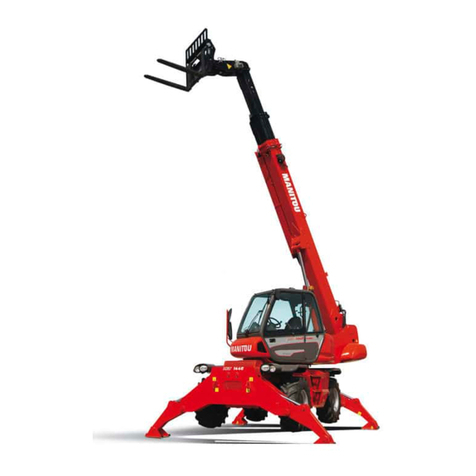
Manitou
Manitou MRT EASY 55P 400 ST4 S2 User manual
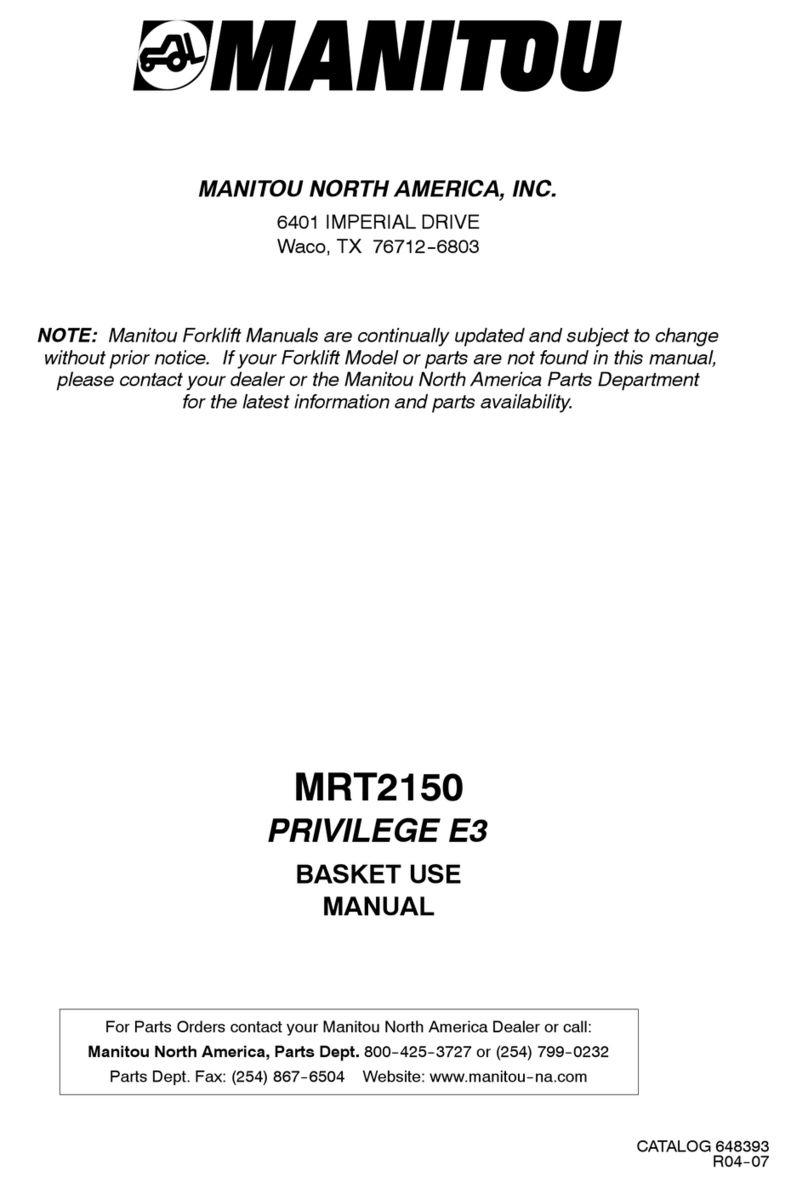
Manitou
Manitou PRIVILEGE E3 Mounting instructions

Manitou
Manitou Privilege MRT-X 3255 PLUS User manual
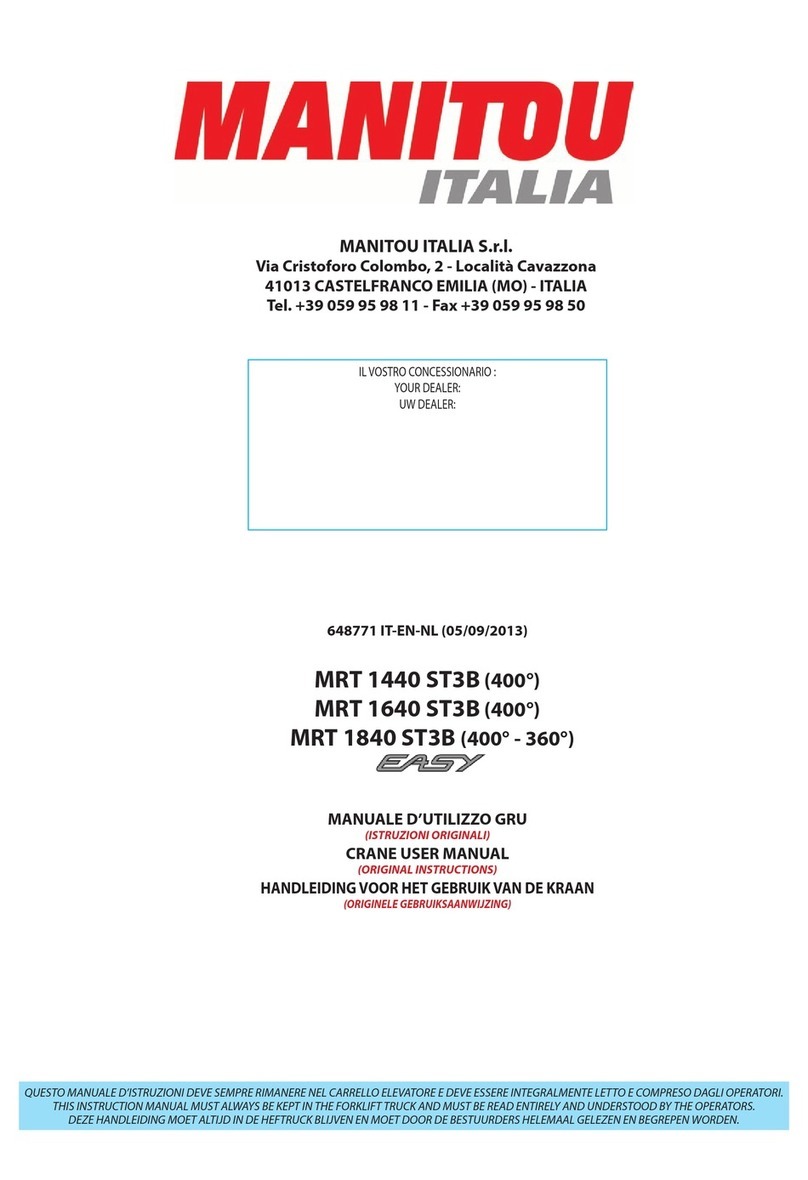
Manitou
Manitou MRT 1440 ST3B User manual

Manitou
Manitou MRT EASY 55P 400 ST4 S2 User manual

Manitou
Manitou Privilege MRT-X 3255 PLUS User manual
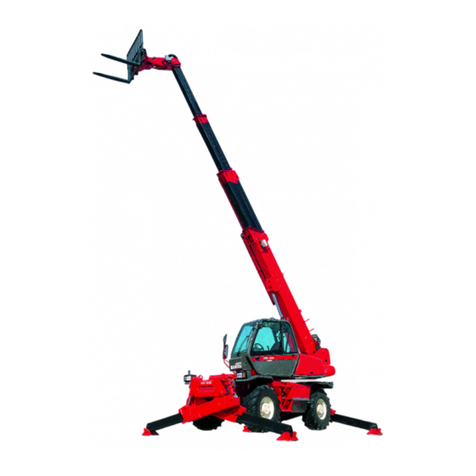
Manitou
Manitou MRT 1850 Turbo M Series User manual

Manitou
Manitou MRT 2150 Privilege Plus ST4 S2 User manual

Manitou
Manitou MAN GO 12 Operating instructions
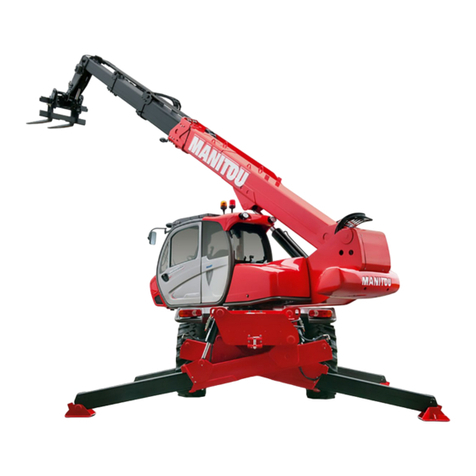
Manitou
Manitou MRT-X 2150 Privilege Plus ST3A S2 User manual

